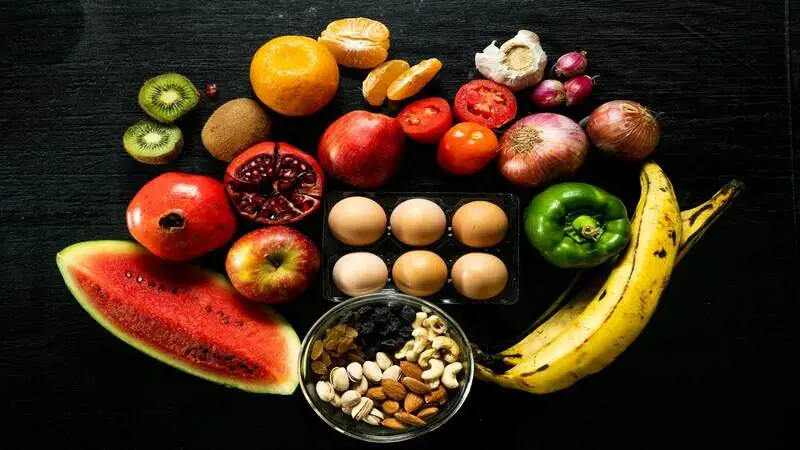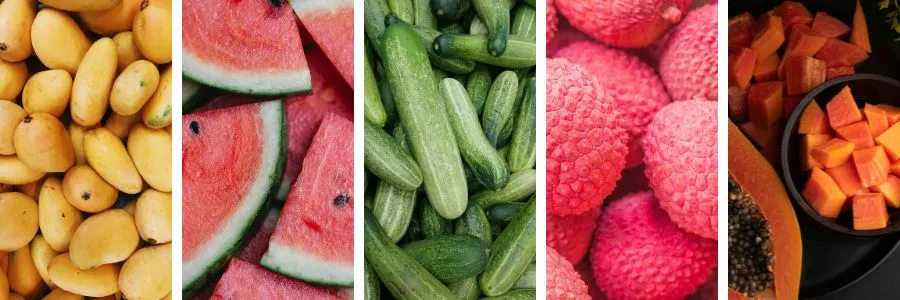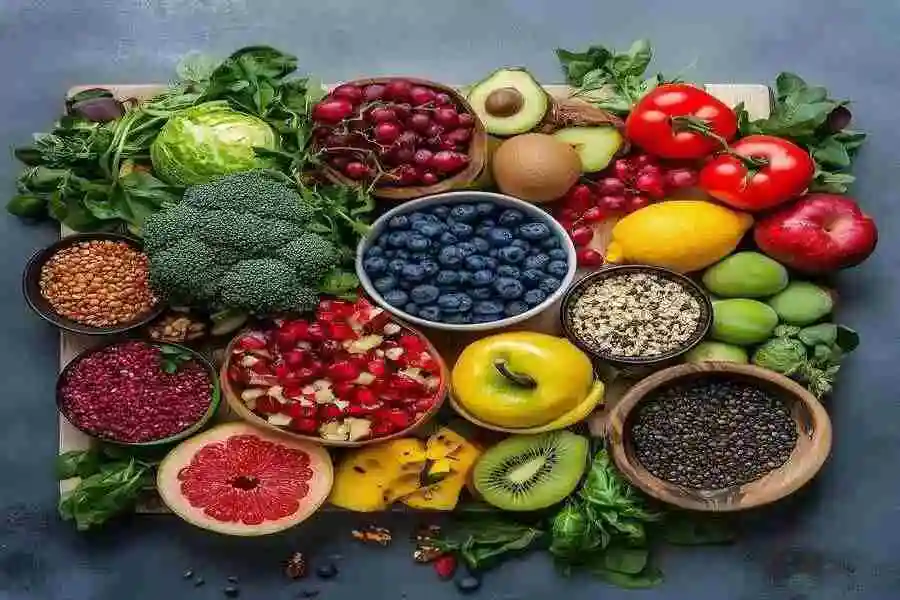Healthy & Balanced Diet Guide for Kids: Practical Tips for Parents
A balanced diet is vital for shaping the physical, mental and emotional health of the growing child. While good nutrition is essential for the child, its importance becomes much more crucial in the early years of the child. As parents of such kids, ensuring that the child gets the right combination of these nutrients can become overwhelming at times, especially when the kids are picky and choosy with food.
In this article, we will explore everything you need to know about a balanced diet for your kids. It will cover all aspects like understanding the age-specific nutritional needs, the fussy eating habits, meal planning strategies, and how to involve your kids in the kitchen. You will also know about the essential superfoods for the kids, seasonal fruits and the vegetables to boost the immunity in children.
We will also cover the healthy ways to introduce these foods to kids without compromising the nutritional value of the food. This practical guide will help parents build lifelong healthy eating habits in children. along with the appropriate quantity of food, since the tender age demands it. Here, we throw some light on children’s healthy and balanced diet tips, which can come in very handy for the parents.
Importance of a balanced diet & the role of macro and micro nutrients
During the first five years of life, the quality of the food determines the health of the bone growth and the brain development of the child. Therefore, taking a balanced diet, which is nutrient-rich too, is extremely important during childhood.
a) Foundation for a Healthy Life
The kind of food that kids take in during the early years of their growth determines their health in the later years. We can say that the nutrient-rich food given to the baby in the first five years paves the way for better health in the future. Some of the benefits of providing a balanced diet to your kid are
Physical Growth
The child’s body growth is maximum in the early years and being fed with proper nutrient-rich food ensures healthy bone growth and good muscle development of the growing child.
Brain Development
Taking a balanced diet with the essential nutrients like omega-3 fatty acids, iron, and vitamins helps in the overall cognitive development of the brain of the growing baby.
Immunity building
A diet full of nutrition makes the immune system strong, besides reducing the risk of frequent illnesses like common colds and infections in the growing baby. Meeting the daily requirements of the body in shape.
b) The role of macronutrients (carbs, proteins, fats) in a balanced diet
The body cannot sustain itself without food for many days, but equally important is the role of nutritious food at that. The carbohydrates, proteins and fats, which are combinely called ‘macronutrients’, are especially important foods for the balanced diet of the child in the early years. These meet all the requirements of the child’s body while growing, which ensures healthy growth. These can be explained as:

Carbohydrates
Carbohydrates include sugars, starches, and fibers — all of which are types of carbohydrates with different roles in the body. These carbohydrates are converted by the human body into sugars, which provide the energy we need to function properly. Therefore, these carbohydrates need to be included in your kid’s diet. Make sure that your child eats whole grains like wheat, brown rice, and millets instead of refined options.
Proteins
Proteins are essential for building muscles and repairing worn-out tissues of the body. Include dals, eggs, paneer, and lean meat in your child’s diet so that the aim of providing a healthy and balanced diet to the child is achieved.
Fats
Healthy fats are also important for the proper growth of the body. You must include nuts, seeds, and ghee, which help in brain development and energy storage. amd
c) Role of micronutrients (vitamins & minerals) in a balanced diet

The micronutrients, which consist of Vitamins and Minerals, are needed by the body for proper functioning. Even though they are not the primary sources of energy, their involvement is essential in the metabolic processes, which ensure that our body gets energy from the fats, carbohydrates and proteins. Any depletion of these can result in an immune deficiency in the body and other complications in the child. Some of the important micronutrients that constitute a balanced diet are
- Calcium for strong bones (milk, yogurt, spinach).
- Iron for preventing anemia (jaggery, beans, green leafy vegetables).
- Vitamin C for boosting immunity (oranges, guavas, amla).
Understanding the nutritional needs of children by age groups
We must ensure the right quantity, quality and frequency of food that you give the child to fulfill the Healthy Diet Balance criterion. There are stages of growth of a child and providing the right food at this stage is essential. As a parent, you are the best person who understands the needs of the child and sticking to the schedule will prove beneficial towards achieving the balanced diet plan. Some of the nutritional needs of the child at different ages are
i) Infants (0-6 Months)
Exclusive Breastfeeding is required at this stage since the mother’s milk provides all the essential nutrients and hydration to the baby, besides producing antibodies for fighting infections. The feeding schedule needs to be set up for the baby and essentially, the frequency of breastfeeding should be after every 2-3 hours or as required by the baby.
For some of the mothers who can’t breastfeed the baby due to any condition or situation, the formula milk should be fed to the baby till the mother reaches the stage where she can feed the baby herself.
ii) Weaning Phase (6-12 Months): Gradual Introduction of Solids
At this stage, the baby can be fed mashed fruits like a banana or an apple. In vegetables, some boiled or pureed vegetables like carrots and pumpkin should be given. The baby can also be fed some cereals like ragi or rice, which are also a rich source of iron, calcium, potassium and magnesium, which adds to the balanced diet.
You can start with the purees and then gradually move towards mashed food or the soft and small portions. Ideally, you should introduce one food at a time to test for any allergy to any food. You must avoid salt, sugar and honey till the baby completes one year.
iii) Toddlers (1-3 Years): Establishing Eating Habits
This stage requires you to introduce your child to more solid foods for bone growth and brain development. You can introduce milk and milk products for calcium and fish or walnuts for the omega-3 fatty acids for brain development.
You can feed these to the baby frequently in small portions. To make it more fun for the kid, offer colorful plates with mixed textures and encourage your child to self-feed.
iv) Preschoolers (4-6 Years): Building a Routine
For the preschoolers, building a routine is a must. Here, you must ensure 3 meals and 2 healthy snacks every day. Your focus should be on fiber content, so that the baby is not constipated and the ideal foods for this are whole grains, fruits and vegetables. Try to reduce the junk food, such as sugary snacks, processed foods and sugary drinks as much as possible.
v) School-Age Children (7-12 Years): Energy and Growth Spurt
School-going children have more energy needs at this stage, as they tend to be more active and indulge in more physical work than ever before. Since the importance of a balanced diet is more in these years, you can introduce whole grains, fruits, proteins and dairy-related foods.
Also, nuts should be included in the diet to boost energy levels. You can give homemade food like roasted makhana, chivda or vegetable sandwiches for lunch and encourage plain water rather than the packaged juices or soda.
vi) Adolescents (13-18 Years): Coping with Puberty and Increased Demands
This age is very important and at the same time a delicate one, as this is just the beginning of your kid’s foray into the adult world. The kid needs more diverse and nutrient-rich food to cope with the ever-increasing demand of the body for strong body and full growth. You must feed them adequately with a balanced diet and according to the minerals required. Some of the nutrient-rich foods and most essential for growing kids are:
Protein-Rich Diet
This type of diet supports rapid growth and hormonal changes, which take place in your child’s body. Examples are eggs, dals, chicken, soy products, etc.
Iron and Calcium
Both boys and girls need extra calcium during these years for greater bone density. Also, girls at this stage need extra iron due to menstruation, which takes place at this stage. Examples are spinach, red meat, seafood, beans, green leafy vegetables and dry fruits.
If your child is a fussy eater, don’t worry — we’ve got you covered! 👉 Check out our complete guide on how to handle picky eating in children.
Some superfoods for growing kids
Some foods are especially preferred if you want your child to grow and develop in the healthiest way. These are the powerhouses of energy and rich in nutrition, which are essential for your growing kid and a nice way to plan a balanced diet for your child. Some of them are

Ragi (Finger Millet)
Ragi is a rich source of calcium, which is essential for the growing bones and teeth of your child. Some of the benefits of Ragi are that it is
- High in dietary fiber.
- Aids in digestion.
- Contains iron, which supports brain development.
- Ideal recipes include ragi porridge, ragi dosa, or cookies, which you can prepare at home and serve to your kid.
Paneer (Indian Cottage Cheese)
By adhering to nutrient-rich foods for your kids, you can ensure that they get a healthy and strong body. This is achieved only if the child gets adequate sources of protein as part of a balanced diet, as they are essential for muscle building. Besides proteins, the cheese has high calcium and vitamin D, along with good fats, which should make it a great choice for your kid’s diet. It can be used as a stuffing for paranthas or in the curries and simply grilled and included in your child’s plate.
Lentils (Dal)
Lentils are a very good source of vitamin B, iron, and potassium. They also contain high levels of protein and fiber, which help to restore energy levels in the body and boost the immune system. From dal soups to khichdi, lentils are versatile and easily digestible for kids. They constitute a great, healthy and well-balanced diet for the kids.
Other Indian Staples
Ingredients like ghee (clarified butter) for healthy fats, jaggery for iron, and turmeric for its anti-inflammatory properties are also excellent additions to a child’s diet for healthy eating.
Seasonal Fruits and Vegetables to Boost Your Child’s Immunity
In today’s globalized world, markets are flooded with a wide variety of fruits and vegetables year-round. However, not all produce is created equal when it comes to supporting your child’s health. Seasonal fruits and vegetables are not only fresher and more nutritious, but they also align better with the body’s natural needs during that particular time of the year.
Let’s explore why seasonal produce matters and how to incorporate it into your child’s diet.
Why Choose Seasonal Produce?
- Fresher and Tastier: Seasonal fruits and vegetables are harvested at their peak, which means better taste and texture.
- More Nutrient-Dense: They retain more vitamins, minerals, and antioxidants because they haven’t been stored for long or artificially ripened.
- Better for Immunity: Our body craves different nutrients depending on the season (e.g., Vitamin C-rich fruits in winter), and seasonal foods deliver them naturally.
- Fewer chemicals used: The seasonal foods, most of the time, are not dependent on pesticides and chemicals and thus grow more naturally
Immunity-Boosting Fruits by Season
A few fruits, considered seasonal, that you can include in your kid’s diet, are given as
Winter Fruits

- Oranges – Packed with Vitamin C for fighting colds
- Guavas – Extremely rich in fiber and Vitamin C
- Amla (Indian Gooseberry) – A traditional immunity booster
Summer Fruits

- Mangoes – Quite rich in antioxidants and beta-carotenes
- Watermelons & Cucumbers – Hydrating and cooling
- Litchis & Papayas – Great for digestion and immunity
Monsoon Fruits

- Apples and Pears – Improves gut health in helps in digestion
- Jamun (Black Plum) – Helps fight infections
Seasonal Vegetables to Support Immunity
Include these immunity-boosting veggies based on the seasons:
Winter Vegetables

- Spinach – Rich in iron, folate, and Vitamin K
- Carrots – Rich in beta-carotene, which is good for immunity and eye health
- Radishes – Helps in the digestion process and detoxification
Summer Vegetables

- Bottle Gourd (Lauki) – Keeps the body cool and hydrated
- Pumpkin – Rich in antioxidants and Vitamin A
- Bitter Gourd (Karela) – Helps purify blood and improve immunity
Monsoon Food

- Turmeric Root – Anti-inflammatory and natural antiseptic properties
- Beans & Okra (Bhindi) – Easy to digest and fiber-rich
Meal planning tips for busy parents for a well-balanced diet
Meal planning is a lifesaver for busy parents, ensuring that children get nutritious meals while minimizing last-minute stress. Preparing the weekly meal plans goes a long way in ensuring that everything falls in place on time and the efforts yield good results for a balanced diet. Preparing the weekly meal plan helps to
- Save time during hectic mornings and evenings.
- Reduce reliance on unhealthy takeout or processed foods.
- Maintain a balanced diet with proper nutrients.
Steps for a Weekly Meal Plan
Evaluate Family Preferences and Needs
- Identify your child’s favorite meals, balancing taste with nutrition.
- Consider dietary restrictions like allergies or vegetarian preferences.
Plan Around the Week’s Schedule
- Allocate simple, quick recipes for busy weekdays and more elaborate dishes for weekends.
- Example: Opt for one-pot meals like khichdi or vegetable pulao on school nights.
Use Time-Saving Techniques
- Batch Cooking: Prepare staples like dal, rice, or soups in bulk and store them for the week for a balanced diet.
- Pre-Chopped Ingredients: Chop vegetables and marinate proteins in advance.
- Meal Prep Kits: Divide ingredients for specific recipes into containers for easy cooking later.
Stick to a Shopping List
- Draft a list based on your weekly menu to avoid impulse purchases and save money.
- Include pantry essentials like grains, spices, and quick snack options.
Sample Weekly Plan
Monday: Vegetable sandwich with milk for breakfast; rice pulao for lunch; dal and roti for dinner.
Tuesday: Idlis with chutney; chapati rolls for lunch; dosa with sambar for dinner.
Wednesday: Masala oats; khichdi variations for lunch; spinach pulao for dinner.
Encourage healthy eating habits in your kids
Children learn primarily by observing their parents. Modeling good eating habits is one of the most effective ways to instill healthy behaviors in children and to sustain a balanced diet plan in your family.
Key Strategies to Model Healthy Eating for a Balanced Diet
- Eat Balanced Meals Together
- Sit down for family meals where everyone eats the same nutritious food.
- Avoid separate “kid meals,” encouraging them to eat the family’s menu.
- Demonstrate a Positive Attitude Toward Food
- Avoid labeling foods as “good” or “bad.” Instead, focus on moderation and balance.
- Express enthusiasm for trying new foods, like exotic fruits or seasonal vegetables.
- Maintain Regular Meal Times
- Structure meals and snacks at consistent times to build a routine.
- Avoid skipping meals, as this can confuse children about proper eating habits.
- Be Mindful of Portion Sizes
- Serve appropriate portions for yourself and your child to teach moderation.
- Limit Unhealthy Food Choices
- Keep sugary snacks, junk food, and processed drinks as occasional treats.
- Store healthy snacks like fruits, nuts, or roasted makhana within easy reach.
Example
If parents snack on fruits instead of chips, children are more likely to follow their example. Similarly, trying a new vegetable together can help normalize its inclusion in meals.
Introduce reward systems that promote healthy food choices
Reward systems can positively reinforce healthy eating, provided they focus on long-term habits rather than instant gratification. Introduce the same in your family so that the kids get a balanced diet as per the plan.
Types of Effective Reward Systems
Non-Food Rewards
Use praise, stickers, or small rewards like extra playtime instead of offering unhealthy treats as rewards.
Example: “If you finish your vegetables all week, we’ll go to the park on Sunday.”
Healthy Food Challenges
Introduce challenges like “Eat the Rainbow,” where children earn points for trying different-colored fruits and vegetables throughout the week.
Offer a prize for consistent efforts, like choosing a family activity or movie night.
Interactive Meal Prep as a Reward
Let children choose a recipe or decide on a theme for one family meal if they meet their healthy eating goals.
Behavioral Rewards for Consistent Habits
Create a rewards chart where they earn stars for drinking water, eating their greens, or trying a new food.
Offer bigger rewards after accumulating stars, like a new storybook or art supplies.
Some of the frequently asked questions
What is a balanced diet for kids?
A balanced diet for kids includes a mix of proteins, carbohydrates, healthy fats, vitamins, and minerals. It should include fruits, vegetables, whole grains, dairy, and lean proteins.
Why is a balanced diet important for children?
A balanced diet helps in growth, brain development, immunity, and maintaining energy levels. It also prevents nutritional deficiencies and childhood obesity
How can I get my child to eat a balanced diet?
Make meals colorful and fun, involve kids in meal prep, set a good example, and introduce healthy foods gradually without forcing them.
What are the best sources of protein for kids?
Eggs, dairy products, lean meats, fish, beans, lentils, and nuts are great protein sources for growing children
How much water should kids drink daily?
Kids should drink about 5-8 cups of water daily, depending on their age, activity level, and climate.
Can kids have treats and still maintain a balanced diet?
Yes! The key is moderation. Allow occasional treats while ensuring their main diet is nutrient-rich.
What are some easy and healthy snack ideas for kids?
Fruits with yogurt, whole-grain crackers with cheese, homemade smoothies, nuts, and veggie sticks with hummus are great snack options.
How can I ensure my picky eater gets enough nutrients?
Try smoothies, mix veggies into favorite foods, offer a variety of options, and avoid pressuring them to eat.
What are the essential vitamins and minerals for kids?
Key nutrients include calcium (for strong bones), iron (for brain development), vitamin C (for immunity), vitamin D (for bone health), and fiber (for digestion).
How many meals should a child eat in a day?
Children should ideally have three main meals and two healthy snacks throughout the day to maintain energy and proper growth.
Is milk necessary for a child’s balanced diet?
Milk is a good source of calcium and protein, but if your child is lactose intolerant or doesn’t like milk, alternatives like yogurt, cheese, tofu, leafy greens, and fortified plant-based milk can provide similar nutrients
Can my child be a vegetarian and still have a balanced diet?
Yes! A vegetarian diet can be balanced with plant-based proteins like lentils, beans, tofu, nuts, dairy, and whole grains. Make sure they get enough iron and vitamin B12.
What should I do if my child refuses to eat vegetables?
Try blending veggies into soups, pasta sauces, or smoothies. Offer different preparations (raw, steamed, roasted) and involve kids in choosing and preparing veggies
How can I reduce sugar in my child’s diet?
Limit sugary drinks, avoid processed snacks, offer naturally sweet foods like fruits, and check food labels for hidden sugars
Are store-bought juices healthy for kids?
Most store-bought juices contain added sugars and lack fiber. It’s better to offer fresh fruit or homemade smoothies. If buying juice, choose 100% fruit juice and limit it to 4-6 oz per day
How much protein does a child need daily?
1-3 years: 13g/day
4-8 years: 19g/day
9-13 years: 34g/day
Good sources include eggs, poultry, fish, beans, lentils, and dairy.
Can kids follow a low-carb diet?
Children need carbohydrates for energy and brain function. Instead of cutting carbs, focus on healthy sources like whole grains, fruits, and vegetables rather than refined sugars and processed foods.
How can I make sure my child eats enough fiber?
Include whole grains, fruits, vegetables, beans, and nuts in their diet. Whole wheat bread, oatmeal, apples, and carrots are great fiber-rich choices.
What are some healthy lunchbox ideas for school?
Whole wheat sandwich with lean protein and veggies.
Yogurt with granola and berries.
Homemade hummus with veggie sticks.
Boiled eggs with whole-grain crackers.
Fruit slices with nut butter.
What are the best breakfast foods for kids?
A balanced breakfast includes protein, fiber, and healthy fats. Good options are:
Oatmeal with nuts and fruit.
Scrambled eggs with whole-grain toast.
Greek yogurt with honey and granola.
Smoothies with spinach, banana, and yogurt








